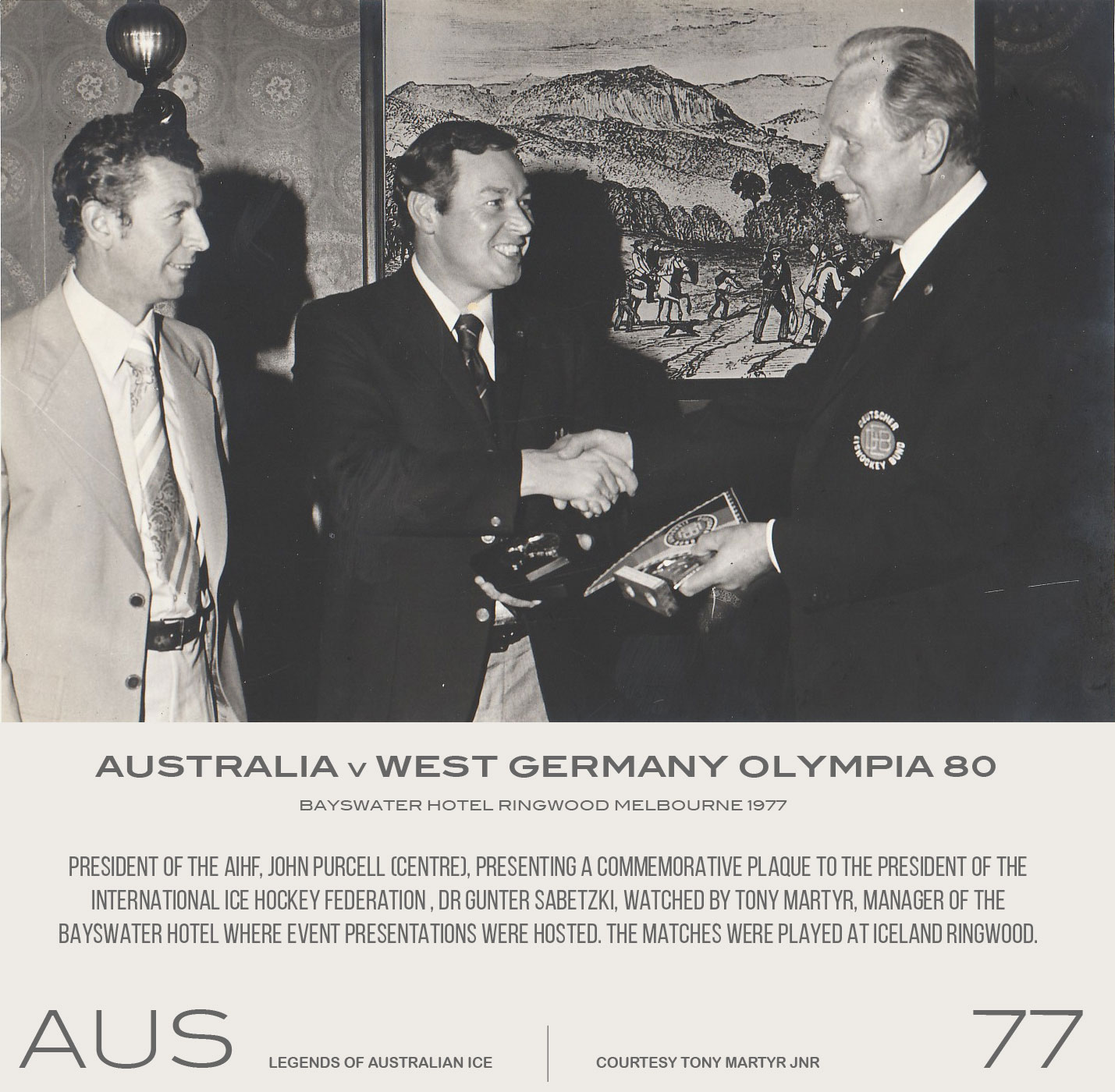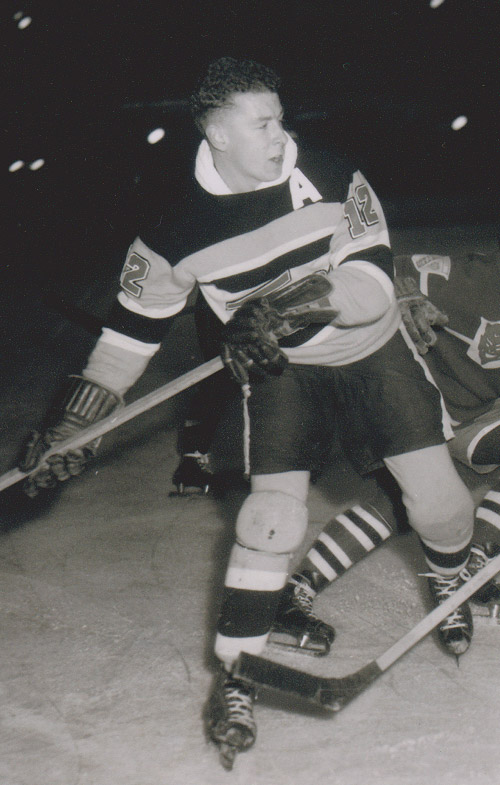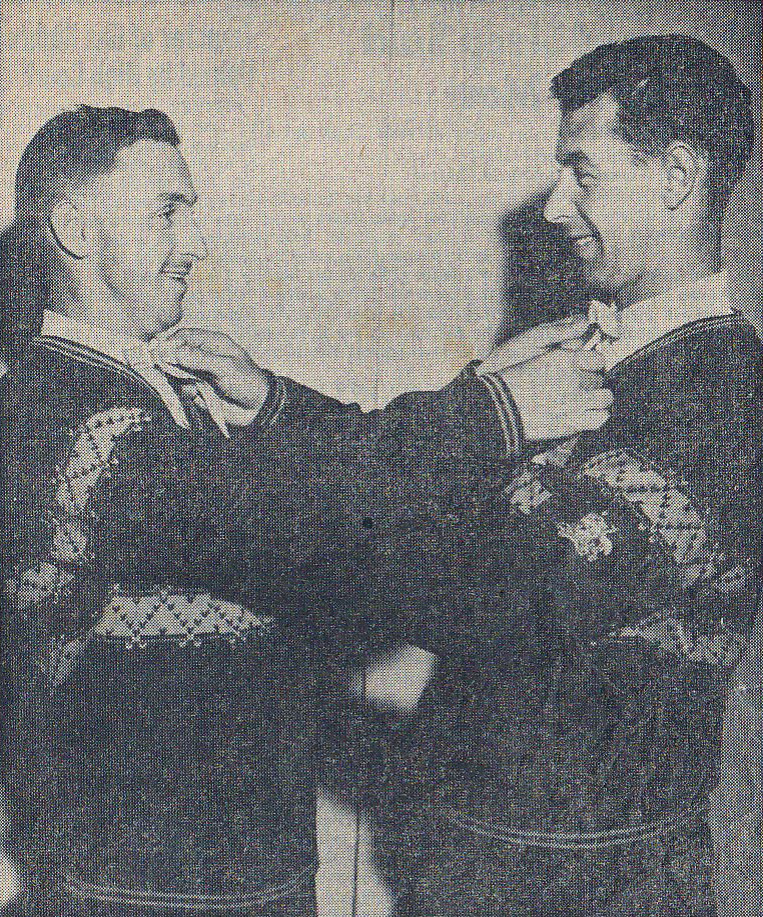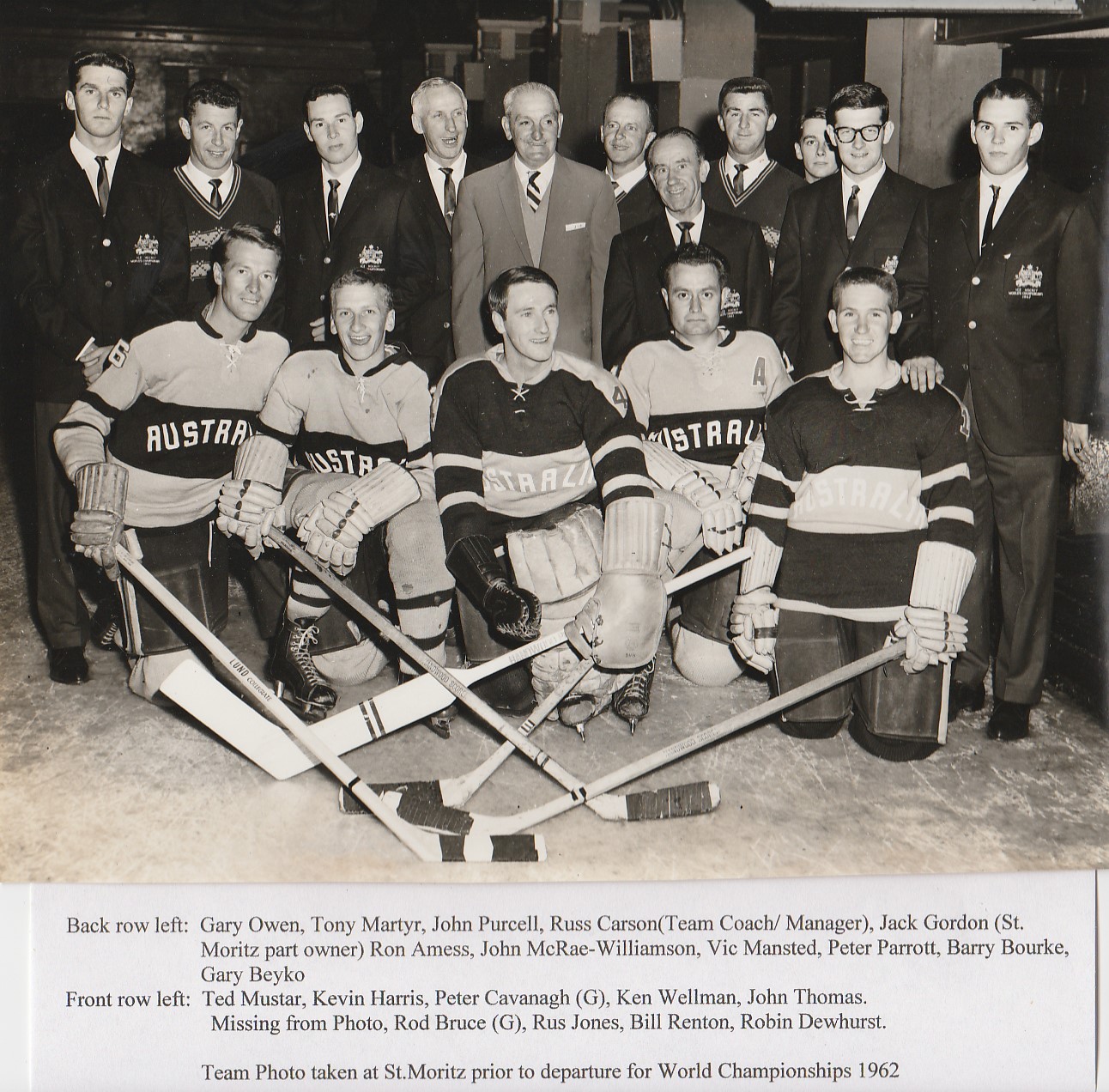
Adventures in Paradise
Tony Martyr and the never-ending game
![]() With a lot of good strong sides already developed, crafty coaches, a whole horde of young and up-and-coming men battling for a place in a team, increased popularity through TV and crowded attendances, the game must go ahead. Some day we hope to attain world-standing and at the present rate of improvement, that should not be too far distant
With a lot of good strong sides already developed, crafty coaches, a whole horde of young and up-and-coming men battling for a place in a team, increased popularity through TV and crowded attendances, the game must go ahead. Some day we hope to attain world-standing and at the present rate of improvement, that should not be too far distant
— Tony Martyr Snr, 1958. [2]
 — With the Tigers and the Demon's Brian Jose, Melbourne, 1956. [1]
— With the Tigers and the Demon's Brian Jose, Melbourne, 1956. [1]
THE FIRST TIME I SAW TONY MARTYR he was wearing a bottle-green blazer and was dropping a ceremonial ice hockey puck onto the frozen surface of a decrepit rink in Oakleigh South. He was born in Melbourne long before the rink, on the fourth of July 1934. Yet, even approaching his eightieth year, he was much less elderly and infirm than the neglected cash cow of the ambitiously named Olympic Ice Skating Centre. Visibly alert when we were introduced, I recall the twinkle in his eyes still today, the hint of a good time, of one mischief or another.
Fifty years earlier in 1959, he hobbled off the ice during training tryouts for the Australian ice hockey team to participate in the 1960 Winter Olympics in Squaw Valley, USA. He was twenty-five and heartbroken, having saved his pennies for ages to pay his way if he won a place, [2] until the broken ankle ruled him out of Olympic contention just prior to final selection. [1] His total injuries up until then amounted to a mere seventeen stitches, three broken noses, and the usual bruises, contusions, and strains. [2]
Asked back then for his opinion on the future of the game, he thoughtfully opened a fresh bottle of Melbourne Bitter, and nonchalantly flipped the bottle-top into the interviewer's beer glass. "Terrific!" he said. "With a lot of good strong sides already developed, crafty coaches, a whole horde of young and up-and-coming men battling for a place in a team, increased popularity through TV and crowded attendances, the game must go ahead. Some day we hope to attain world-standing and at the present rate of improvement, that should not be too far distant". [2]
A few years later, he was selected for the 1962 World Championships in Colorado Springs, USA. A starting defenseman in the first ever game Australia won at international level, a 6-2 victory over Denmark. He witnessed thirty penalties in that series managed by his friend Syd Tange, and injuries to six of thirteen teammates requiring hospital, masseur or doctor attendance. [3]
In 1963, the IOC allocated a single qualifying position to a country from the Asia-Oceania region for the 1964 Winter Olympics. In November, he was selected to Australia's qualification team, but not in defense. He was on the forward line. [1] Australia was beaten in both games by a much more experienced host team from Japan, effectively ending the nation's attempt at Olympic ice hockey re-qualification. [3]
THE BOY WHO PLAYED FOOTBALL for the St Kilda seconds, cricket with Armadale, and C-Pennant tennis with South Caulfield might easily be misunderstood these days, but his hobbies in those years were ice hockey, ice hockey, ice hockey, and skating at every opportunity. He ran around the park every other day, until he was a very fit 1.7m (5-ft 9-inch), 81 kg (12-stone 10-lbs) athlete. [2]
He first played ice hockey with the Tigers at St Moritz St Kilda in 1948. He was thirteen and still a tot compared to emerging young guns such as Dave Cunningham and Rus Jones who developed earlier in the training sessions held in Melbourne during the war years.
Up until 1948, Australian ice hockey had been controlled with variable success by officials elected to honorary positions, much as it is today. But the Board of Management of Glaciarium Ltd, one of the two Melbourne rinks, felt this was retarding the game's progress, and decided to completely take over control and promotion. The move triggered an all-time boom in growth and prosperity — a fifties Golden Era that was to last for over ten years. [5]
The prime movers were Leo Molloy, Managing Director of the rink management company since the early-1920s; Cyril MacGillicuddy, its chairman; and Ted Molony, one of its directors. Molony and MacGillicuddy had both been significant athletes and officials, both in ice hockey and ice skating. "Growth in the last two years has been beyond expectations," wrote Raiders defender, Carol Martin, in an April 1949 article for London's Ice Hockey World and Skating Review. "Playing standard improved and general conditions of the game are of a very high standard, such as organisation, amenities and playing conditions". [5] The Victorian game was in very good shape during Tony Martyr's formative years.
In his second season at 14, he was playing Senior-B with regular games in the A-Grade. By 1952, he was a permanent A-Grade team member at Left Defense, [2] and then captain from 1956 to '59. Over the first eight seasons of boom town A-grade hockey, buoyed by an unprecedented influx of New Australians with overseas experience, he only ever sat five penalty minutes, [2] and he earned many individual honors, including Club MVP in 1956 and 1958. [1]
Office Manager for Clyde Batteries in those years, his employer allowed him time off for practice, which was just as well because he was also a Sergeant (Transport Officer) in the 2nd Field Regiment of the CMF, today's Army Reserve. [2] On the eve of Olympic selection, after ten years of service and over one-hundred-and-twenty senior games (1959), he was awarded Life Membership of the Tigers. [1] Yet, it was still only the beginning of a long, long sporting career.
In March 1961, he joined the Melbourne Blackhawks in the same league and remained there for two-hundred-and-seven games. He was selected to represent Victoria for the first time at senior level in 1961 when the Goodall Cup returned after a six-year interruption that began with the closure of the old Sydney Glaciarium.
Victoria won that season and again in 1962. He played in the 1963, '64 and '65 Goodall Cup teams. Appointed captain of the Blackhawks that season, he led them to the H H Kleiner Trophy, Victoria's A-Grade Championship, and he was also a member of the 1962, '63 and '65 state champion teams and the '65 Australian Club Champions.
In July 1966, he underwent major surgery, but rehabilitated sufficiently to be selected for the Victorian Brown Trophy team. He won the 1966 title during the years it was the Reserve Goodall; a contest for players not selected to their respective Goodall Cup teams, which was quite removed from the aged-delimited competition the Brown Trophy eventually became. [1]
Back in the state Goodall team in 1967, he was appointed captain following the withdrawal of Noel Derrick from the Tournament due to a serious facial injury inflicted half-way through the first game. [4] His alternates were Kevin Harris and John Thomas [4] and together they led the team to their third consecutive Goodall Cup. He played the 1968 and '69 tournaments and was selected three times for the All-Australian team. He represented Victoria a total of nine times at both Goodall and Brown level, [1] holding the Goodall Cup high over his shoulders on five occasions.
Elected president of the Blackhawks in 1970, he was awarded Life Membership of the Club before retiring as an elite player at the age of thirty-eight in December 1972. Elected to the VIHA Tribunal that season, he became its chairman in 1973, and served as the AIHF Tribunal Chairman during the 1977 visit to Melbourne by the German Olympic Ice Hockey Team.
In the years before he left for Queensland in 1981, he headed-up the VIHA Tribunal, but found the urge to play irresistible. In 1974, he joined the newly-formed Melbourne Nite Owls old-timers. A member of the group that worked towards the creation of OIHAN, the old-timer's network which is still active to this day, he continued to regularly play with the Nite Owls for the next few years before retiring as a player at the end of the 1980 season. [1]
THE GOLDEN RIBBON OF SAND at Surfer's Paradise on Australia's Gold Coast is world renowned, but white sand beaches stretch across fifty-seven kilometres of the city's coastline. Here, in the sunny, sub-tropical climate of Australia's largest non-capital city, with its high-rise dominated skyline, theme parks, night-life and rain forest hinterland, you can expect hot humid summers and warm winters. Here, more than any other place on Earth except deserts, you could be forgiven for thinking the only ice to be found will be inside an Esky.
Gold Coast culture orbits around its "sun, sand, surf and sex" marketing, but there is still also evidence of resident-driven sub-cultures such as territorial surf gangs similar to the infamous Bra Boys of Maroubra, the beachside suburb of Sydney to the south. Then there are the Finks, Bandidos and Lone Wolf bikie gangs that have traditionally controlled the territory between Surfers Paradise and Coolangatta. More recently rival gangs have moved in, among them Canada's Rock Machine who have a long-running feud with the Hells Angels.
Surfing has always had its own culture, particularly in Australia, and the prospect of Gold Coast lifestyle has probably enabled expat Canadians such as Dave Emblem to attract sufficient overseas interest from elite hockey players to what is now regarded as one of the country's most fickle sporting markets. No Gold Coast based club has yet won a national premiership in its code, yet Emblem came close in the Australian Ice Hockey League managing the Golden Coast Blue Tongues from 2008 until the club's demise in 2013. Blue Tongues alumni include former NHL 3-gamer, Gaetan Royer, among numerous other notable imports.
It was here, over thirty years earlier, with the opening of the brand new Skateworld facility on the Gold Coast, that Tony Martyr became a Level-1 coach of the new junior ice hockey program. Then, in the wake of rink closures at Toombul and Toowoomba, the sport in South East Queensland was again left without a venue when the Skateworld facility was forced to close towards the end of 1985. Although the Surfers Paradise Ice Bubble was just a rectangular sheet of ice with a kick-board and steel tube handrail, it enabled at least a basic form of ice hockey to return to the Gold Coast when it opened its doors less than twelve months later. [1]
Martyr was part of the quickly reformed Gold Coast Vikings old-timers team which took on the visiting North Shore Old Goats from Vancouver in a single-game exhibition. The clash identified a need for a permanent Queensland old-timers team, which led to the founding of the Queensland Rusty Blades. Martyr was a foundation member, and the Blades went on to become a regular participant at old-timer tournaments hosted all around the country. [1]
The loss of the Ice Bubble in 1987 once again left South East Queensland without an ice hockey venue. Since its opening in the late-70s, Brisbane's Acacia Ridge rink had never permitted ice hockey, but this changed in 1988 and a non-contact senior competition was quickly organised. The Brisbane Ice Hockey League (BIHL) initially consisted of three teams and Martyr joined the reformed Gold Coast Vikings team along with the bulk of Gold Coast based players. Although playing regular hockey for the first time in four years, his experience on the blue line was critical in many games, and his contribution helped the Vikings win the inaugural BIHL competition. [1]
Later in 1988, he was appointed Coach of the state Goodall Cup Team. At fifty-five, he again laced-up his skates to contest the Goodall Cup when several injuries early in the tournament depleted an already under-strength team. After a 20-year absence he joined his son, Tony Junior, for the first father and son player combination in a Goodall Cup. [1]
He returned with the Vikings in 1989, helping the team to win back-to-back BIHL titles and the next season he transferred to the Rusty Blades old-timers team which was by then incorporated in the BIHL competition. The team's age and speed disadvantages were compensated by a brand of experience and teamwork that was well-suited to the non-contact rules of the League. The Blades won back-to-back Minor Premierships in 1990 and 1991, and when the BIHL introduced full body contact in 1992, Martyr dropped back to the Senior B competition. There for the next four years, he shared his wealth of experience with many up-and-coming players. [1]
He was elected President of the Queensland Ice Hockey Association for two years (1991, '92) and became Chairman of the state tribunal (1991 to '98, 2001 to '12). In 1991, he was invited with the Nite Owls team to participate in the annual Snoopy Old-timers Tournament in Santa Rosa, California, the first Australian team to contest the world-famous tournament. Still an active player, coach and on-ice official, he was awarded Life Membership of the Queensland association after fifteen years of continued service to the sport in that state.
When the Brown Trophy (U21) returned to Queensland in 1995, after an absence of more than ten years, Martyr was appointed Tournament Director. He played the same role in the 1999 Tange Trophy (U18), a poignant tribute to the relationship he had with Syd Tange over more than 40 years; the combined 2003 Tange and Ginsberg (U13); and the combined 2004 Defris (U15) and McCrae-Williamson. [1]
In 1994, he was appointed Tournament Director of the first interstate women’s tournament between Queensland and New South Wales. He declined to lend his name to the trophy that became the prize for elite women’s ice hockey in Australia, suggesting instead the late Joan McKowen who had passed away less than two years prior. Joan's husband Max accepted, and so it was the McKowen Trophy became the symbol for women’s ice hockey supremacy in Australia. [1]
In 1996, the opening of two new rinks at Boondall in Brisbane and Bundall on the Gold Coast, ushered in the next big expansion of the sport in South East Queensland. Player numbers climbed to record levels with a Club based at each of the three facilities, and the SEQ Inter-rink League was created with competition spanning three age divisions in seniors, and three in juniors. Martyr became foundation playing-Coach for the Gold Coast Grizzlys Senior C team, and a member of a championship winning team in its first season, yet again. [1]
Towards the end of 1996, he was awarded Life Membership of the national association. Soon after, until 2008, his national team jersey from the 1963 Olympic Qualification series was displayed at the AIS Sports Museum in Canberra. At the end of 1997, he was awarded the first Life Membership of the Grizzlys for services rendered to Gold Coast ice hockey since his arrival in 1981, and also to mark his 50th year in the sport. He continued to serve the Grizzlys both as Senior C playing-Coach, and in several administrative roles. [1]
In 2000, his sixth decade in the sport, he was awarded the Queens Medal for services to ice hockey in Australia. In 2001, he celebrated his 100th game for the Grizzlys in style by scoring a goal, and he was appointed chef-de-mission for the Australian team at the IIHF Asian Oceanic U18 Championship in Seoul with wife, Annette, in the role of Assistant Team Manager. [1]
In 2005, at the age of 71, he retired from the South East Queensland inter-rink competition, having played over one-hundred-and-fifty games and winning six Senior C Championships for the Grizzlys. He continued to play old-timers hockey with the Gold Coast Phantoms and again rebounded back from retirement with the Beer Bears in the Gold Coast recreational league (2011). He was also paired in defense with his son, Tony, in the Pucks Senior C team (2014) of the Brisbane United Ice Hockey League (BUIHL). [1]
At eighty-two in 2016, after breaking three ribs in an accidental collision during a Senior C game, he joined the Zodiacs as part of the newly formed BUIHL Senior-D competition. He was by then the oldest registered player in the country, in a team that included a fourteen year-old. The Zodiacs boasted a sixty-eight-year age-gap between the oldest and youngest players. [1]
Finally at eighty-two, Tony Martyr Snr retired. He was joined on the ice by his son, Tony Jnr, for the last few shifts of the last game. Quite fittingly, he took the last shot of the match from the point. A recipient of the Australian Sport's Medal in 2000, he still skates each week and helps coach beginner and first-year players with the Gold Coast Grizzlys junior development program. [1]
In 2018, Tony Martyr Snr celebrated an unprecedented 70 years in the Australian game. The Martyr Cup, the prize for the champion of the Brisbane United Ice Hockey League, is named in his honour.
 — Tony Martyr (right) and Australian goalie, Roddy Bruce, on arrival at the Broadmoor International Center for the 1962 World and European Ice Hockey Championships. Gazette Telegraph photo courtesy Tony Martyr Jnr. [1]
— Tony Martyr (right) and Australian goalie, Roddy Bruce, on arrival at the Broadmoor International Center for the 1962 World and European Ice Hockey Championships. Gazette Telegraph photo courtesy Tony Martyr Jnr. [1]
Notes and bibliography
[1] Biographical notes on Tony Martyr Snr, Tony Martyr Jnr, June 2017. With special thanks.
[2] Meet the Players by Ern Margieson, Ice Hockey Guide, VIHA, July 13th 1958.
[3] Australia's Red Letter Day: Denver Coliseum March 15th 1962, Ross Carpenter, Legends of Australian Ice, 2015
[4] Australian Ice Hockey Carnival program, NSW Amateur Ice Hockey Association, 1967.
[5] Ice Hockey World and Skating Review, article by Carol Martin, London, April 1949


